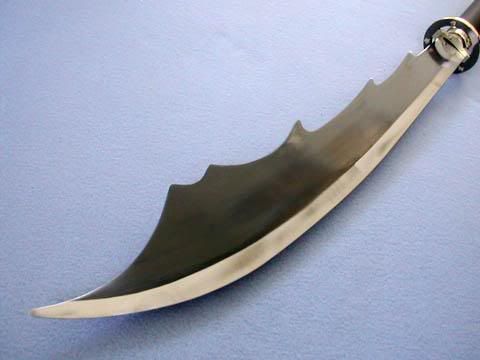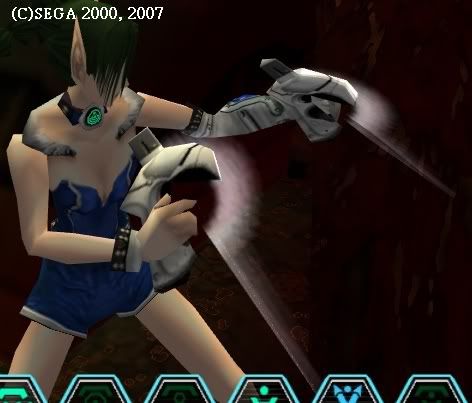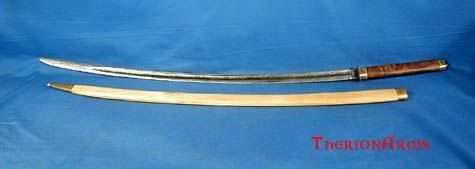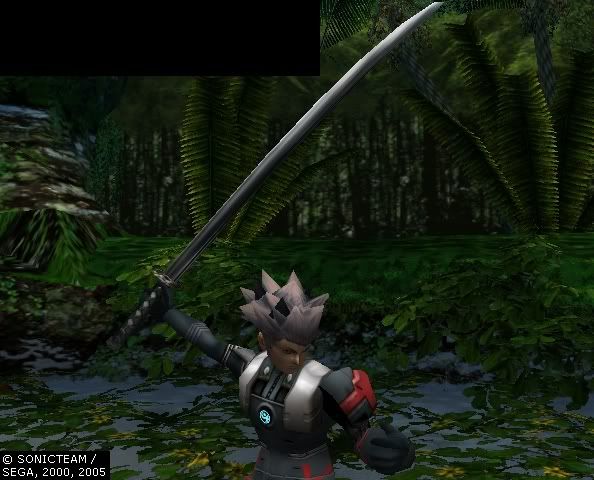
 |
Katana - The Samurai "Slicer"
Well I looked around for a sword thread and didn't find one. Since its not possible to have a japan forum and not talk about Katana's I though I'd make a thread about it.
I will mention here however, that talking only about Katana's will not keep this thread alive for very long. However, on the other hand I want this thread to be related to japan so as to keep with the whole idea of a Japan Forum. That being the case, this thread will contain: 1. Information on Katana (other swords/types may be quoted for comparison purposes only) 2. Pictures of katana. (Other swords may also be shown for comparison purposes) 3. Pictures/descriptions of non-real swords - These are also called fantasy swords. However, it is important that these swords be related to japanese culture in some way for them to find a place in this thread. 4. Pictures/descriptions of swords appearing in Anime - This is an effort to allow posting in this thread regularly since regular anime almost always contains some kind of sword. It is to be noted that not all anime deal with Katanas and in those cases that don't it is still alright to describe or post pictures of those swords here. and lets face it - everybody loves to drool over a cool sword :D Before we move on to the actual descriptions/posts, some dedications are in order (as nard-kun has shown us all :D): I dedicate this thread to... 1. Eki (Gotta start with the boss :D) 2. Gwen, Kudou, Kanji and Vesperd (yep he's now around :D) for modding and maintaining such a wonderful atmosphere here at JF. 3. JF old members (Avary-sama [coz he's the official JF ninja], NinjaKasumi, Samokan-chan and a whole list of others) 4. Some special people (and my oldest friends here) on JF *yay* [I.Doll, Nard-kun, Rikku-dona, Superwoman!] 5. My bestest pals here [All the above :D plus Fuu, Kitski, DT, Carry, Trainy, Hisu, Kakashi, K-cube, Kat, ObscureLove aaaand DR! <and this list goes on and is growing each day> :D] 5. Everybody else! <list too exhaustive to name :D> So without further ado... Edited: I would also like to mention a couple of helpful hints when posting on this thread: 1. Please don't paste pics that are bigger than the page length. Instead paste the link to the pics so we can follow the links to see the pics in their original beauty! 2. Don't quote pictures when you post. Just quote their links. This means that you need to manually and explicitly remove the img and /img tags when quoting people. |
Lets start from the very beginning
What is a Katana?
Katana is a kind of japanese longsword. Almost every culture has come up with their own kind of sword. These swords all have different attributes. Some are short and some are long while others are extremely long! A long sword as the name suggests is a sword that is about 2 ft in length. These are not exact measurements, but are simply a relative measure compared to other knifing tools such as daggers. Long swords have been seen in many races throughout history. What comes to mind immediately are the scots. They had long swords that were straight, and rigid. This is not to be mistaken with a broadsword which is much heavier than a longsword and is (as the name suggests) broader as well. The signature of a Katana on the other hand is that it is curved. This is due to the process through which it is made... which I shall elaborate on in one of the following posts as and when I get to complete the write up. A katana is traditionally the weapon of the warrior class of people. It is sometimes worn along with another shorter sword called the wakizashi. Together these two swords are called daisho. There is also the option of carrying a much smaller knifing tool, imitating a dagger. This "sword" is called the Tanto. Together, these three implements form the complete sword set that a warrior carries around. As can be guessed, the long sword is the one used for open combat, while the shorter swords are used for a variety of other close combat manouvers, stabbing moves and the highly honoured but much resented Seppuku (ritual suicide). Here are some pics of longswords:  Notice that the sword is straight and elongated in the picture above  Notice the thin and long blade with the long hilt for balance. On the other hand, the Katana is slightly curved and not straight. Here are a few pictures: Here is another one  |
that first one's technically not a longsword...not long enough.,..i'd say it's more of a handandahalf...or maybe a short sword
|
The beginnings of the Katana
Legend has it that the katana was invented in the 700BC period in Japan along with the folded steel process. History however, feels differently and facts show us that it is possible the folded steel process was brought in from China during trade.
Swords forged between 987 and 1597 are called koto (lit., "old swords"); these are considered the pinnacle of Japanese swordcraft. Initial swords that were made tended to have the curve at the hilt (handle) while swords made later had the curve move up the blade and closer towards the center of the blade. Swords were usually worn with the cutting edge facing down and mostly on the left side. Why would someone wear the cutting edge up you might wonder. That is true, one would need to be either masochistic or stupid to attempt to pull out a sword edge first! The previous statement however refers to other methods of wearing swords like those hung on the back (both vertically and horizontally). That it was worn on the left is probably attributable to the fact that a large number of the warrior class people were primarily right handed so that their Iaijutsu (sword drawing technique also called Iaido) was more powerful when drawn with the right hand than with the left. Sword fighting however, required the use of both hands to hold the sword. A sword worn in such a manner (left and edge down) is called "Tachi". Wikipedia also cited that the signature on the sword (Called Nakago) would be inscribed in such a manner that it would always show on the outside when worn. Inital japanese swords were not curved like the modern day Katana. They were in fact straight like the original longswords. However, during the Heian period curved swordmaking techniques were developed to serve the use of the military. Military at that time consisted mostly of Cavalry and using a straight sword from horseback was far less effcient when compared to fighting with a curved sword. A curved sword added to a better downward thrust.  |
what about other japanese weapons? because i'm sure i could find a pic of a Naginata or japanese daggers
|
aaaaaaaaaaaaaaaaaaaaaaaaaaaaaaaaaaaaaaaaaaaaaaaaaaaaaaaaaaaaaaaaaaaaaaaaaaa aaaaaaaaaaaaaaaaaaaaaaaaaaaaaaaaaaaaaaaaaaaaaaaaaaaaaaaaaaaaaaaaaaaaaaaaaaa aaaaaaaaaaaaaaaaaaaaaaaaaaaaaaaaaaaaaaaaaaaaaaaaaaaaaaaaaaaaaaaaaaaaaaaaaaa aaaaaaaaaaaaaaaaaaaaaaaaaaaaaaaaaaaaaaaaaaaaaaaaaaaaaaaaaaaaaa
i ADORE katana's aaaaaaaaaaaaaaaaaaaaaaaaaaaaaaaaaaaaaaaaaaaaaaaaaaaaaaaaaaaaaaaaaaaaaaaaaaa aaaaaaaaaaaaaaaaaaaaaaaaaaaaaaaaaaaaaaaaaaaaaaaaaaaaaaaaaaaaaaaaaaaaaaaaaaa aaaaaa:rheart: :rheart: :rheart: |
Quote:
|
OL-Chan!!!!!!!!!!!!!!!!!!!!!!!!!!!!!!! :rheart: I thought you weren't around here anymore. It is sooo good to see you back! I'm going to dedicate this to you too! *Rushes back to edit first post*
@DR - Naginata's coming up in the future posts :D. Like you said they are the special sword types. If you have info right away (or pics) I'd be honoured if you'd post them :D I'll fill in the background as I get the write up complete. This thread has been a while in the making so I'm not complete yet with all the other stuff on my plate :D |
Quote:
as for the naginatas, do you prefer authentic, or modern replicas? |
Quote:
|
Quote:
*danses* we havnes talk in a looooooooooooooooooooooooooooooooooooooooooooooong timeeeeee carry-chan is sqaying hiiiiiiiiiiiii and he's jumping *smiles* |
The parts and terminology in a Katana
Before I progress more into history or sword making I thought it would be informative to put up a diagram of a Katana with all its parts and their japanese names! So here goes...
 I got this pic from Wikipedia! |
this one's an older style, but it's a modern replica...i'll see if ican find a more traditional one
http://www.icefire-enterprises.com/Naginata.JPG tradtional naginata http://www.ginklai.net/images/galeri..._naginata1.jpg i couldn't find the modern variant i wanted, called a Dragon Naginata... also, sorry about not actually posting the pics...didn't feel like converting bitmaps again x.x |
Quote:
*Big hugs to OL and Carry* |
"]*Claps* Great thread Ryuk!:D:pinkclap: And you dedicated some of it to me!!! HOW SWEET!!!:D :rheart:
Ok, since I am such a history/myth/weaponmaking/nitty gritty detail fan, I wanted to post some of that type of stuff...:o I know it;s a lot to read, and the orange does not help...good old Wiki...lol The forging of a Japanese blade typically took hours or days, and was considered a sacred art. As with many complex endeavors, rather than a single craftsman, several artists were involved. There was a smith to forge the rough shape, often a second smith (apprentice) to fold the metal, a specialist polisher (called a togi) as well as the various artisians that made the koshirae (the various fittings used to decorate the finished blade and saya (sheath) including the tsuka (hilt), fuchi (collar), kashira (pommel), and tsuba (hand guard). The forging of a Japanese blade typically took hours or days, and was considered a sacred art. As with many complex endeavors, rather than a single craftsman, several artists were involved. There was a smith to forge the rough shape, often a second smith (apprentice) to fold the metal, a specialist polisher (called a togi) as well as the various artisians that made the koshirae (the various fittings used to decorate the finished blade and saya (sheath) including the tsuka (hilt), fuchi (collar), kashira (pommel), and tsuba (hand guard). The Japanese sword blade is formed from a combination of two different steels, a harder outer jacket steel wrapped around a relatively softer, inner core of steel. This creates a blade which has a hard, sharp cutting edge with an inner core which is resilient and able to absorb shocks in a way which reduces the possibility of the blade breaking or bending when used in combat. The hadagane, for the outer skin of the blade is produced by heating a block of high quality raw steel, which is then hammered out into a bar. This is then cooled and broken up into smaller blocks which are checked for further impurities and then reassembled and reforged. During this process the billet of steel is heated and hammered, split and folded back upon itself many times and re-welded to create a complex structure of many thousands of layers. The precise way in which the steel is folded, hammered and re-welded determines the distinctive grain pattern of the blade, the jihada, (also called jigane when referring to the actual surface of the steel blade) a feature which is indicative of the period, place of manufacture and actual maker of the blade. The shingane (for the inner core of the blade) is of a relatively softer steel with a lower carbon content than the hadagane. For this, the block is again hammered, folded and welded in a similar fashion to the hadagane, but with fewer number of folds. At this point, the hadagane block is once again heated, hammered out and folded into a ‘U’ shape, into which the shingane is inserted to a point just short of the tip. The new composite steel billet is then heated and hammered out ensuring that no air or dirt is trapped between the two layers of steel. The bar increases in length during this process until it approximates the final size and shape of the finished sword blade. A triangular section is cut off from the tip of the bar and shaped to create what will be the kissaki. At this point in the process, the blank for the blade is of rectangular section. This rough shape is referred to as a sunobe. The sunobe is again heated, section by section and hammered to create a shape which has many of the recognisable characteristics of the finished blade. These are a thick back (mune), a thinner edge (ha), a curved tip (kissaki), notches on the edge (hamachi) and back (munemachi) which separate the blade from the tang (nakago). Details such as the ridge line (shinogi) another distinctive characteristic of the Japanese sword, are added at this stage of the process. The smith’s skill at this point comes in to play as the hammering process causes the blade to naturally curve in an erratic way, the thicker back tending to curve towards the thinner edge, and he must skilfully control the shape to give it the required upward curvature. The sunobe is finished by a process of filing and scraping which leaves all the physical characteristics and shapes of the blade recognisable. The surface of the blade is left in a relatively rough state, ready for the hardening processes. The sunobe is then covered all over with a clay mixture which is applied more thickly along the back and sides of the blade than along the edge. The blade is left to dry while the smith prepares the forge for the final heat treatment of the blade, the yaki-ire, the hardening of the cutting edge. This process takes place in a darkened smithy, traditionally at night, in order that the smith can judge by eye the colour and therefore the temperature of the sword as it is repeatedly passed through the glowing charcoal. When the time is deemed right (traditionally the blade should be the colour of the moon in February and August which are the two months that appear most commonly on dated inscriptions on the nakago of the Japanese sword), the blade is plunged edge down and point forward into a tank of water. The precise time taken to heat the sword, the temperature of the blade and of the water into which it is plunged are all individual to each smith and they have generally been closely guarded secrets. Legend tells of a particular smith who cut off his apprentice’s hand for testing the temperature of the water he used for the hardening process. In the different schools of swordmakers there are many subtle variations in the materials used in the various processes and techniques outlined above, specifically in the form of clay applied to the blade prior to the yaki-ire, but all follow the same general procedures. The application of the clay in different thicknesses to the blade allows the steel to cool more quickly along the thinner coated edge when plunged into the tank of water and thereby develop into the harder form of steel called martensite, which can be ground to razor-like sharpness. The thickly coated back cools more slowly retaining the pearlite steel characteristics of relative softness and flexibility. The precise way in which the clay is applied, and partially scraped off at the edge, is a determining factor in the formation of the shape and features of the crystalline structure known as the hamon. This distinctive tempering line found near the edge of the Japanese blade is one of the main characteristics to be assessed when examining a blade. The martensitic steel which forms from the edge of the blade to the hamon is in effect the transition line between these two different forms of steel, and is where most of the shapes, colours and beauty in the steel of the Japanese sword are to be found. The variations in the form and structure of the hamon are all indicative of the period, smith, school or place of manufacture of the sword. As well as the aesthetic qualities of the hamon, there are, perhaps not unsurprisingly, real practical functions. The hardened edge is where most of any potential damage to the blade will occur in battle. This hardened edge is capable of being reground and sharpened many times, although the process will alter the shape of the blade. Altering the shape will allow more resistance when fighting in hand to hand combat Blacksmith Munechika (end of the 10th century), helped by a fox spirit, forging the blade ko-kitsune-maru ("Little fox"). The kami is represented by a woman surrounded by foxes. Engraving by Ogata Gekko (1859–1920), 1873. Attachment 1003 |
Quote:
I should mention here for the benefit of the rest that in the first link the actual length of the rod can be detached and only the hilt and sword used (when in close combat). If we notice carefully we'll see a small groove near the edge of the hilt close to the blade. That's the point where it can be detached... |
Quote:
OMG! You have got to be the kindest person on the planet! What a post! Wow!!! It would have taken me ages to write all that up, so thanx a bunch for helping out! :rheart: How could I not dedicate it to you. You're one of the 4 people who made me feel home at JF when I joined up :rolleyes: I'm going to post a sword making video or something! *Rushes to search for sword making video* |
yaaaaaaaaaaaaaaaaaaaaaaaaaay
love's it<3333333333333333333333333333333333333333333 |
i was wondering about that
couldn't find a pic of the full Dragon Naginata, but here's the blade  |
So here's the vid on sword making that describes all that Rikku-dona put up:
|
Quote:
|
Quote:
Keep 'em coming OL! That's what I wanna see :D :D |
i dunno....it's a modern variant, i dunno if it was ever actually produced in japan
working on finding a pic of japanese daggers, but i may have to go for a pic from PSO, since i'm not finding any pics of the real thing |
*giggles*
sureeeeeee np i adore them *jumps around with amaginery katana* *smiles* |
HOLY GAMOLY! Watching him put that sword away gave me shivers!!!:eek: Awesome video!!
My bro uses Katanas. (Although a tad recklessly and with his silly friends, but hey, he still has some, lol):) Ok, step by step pics. Attachment 1008 After hammering the steel out, it is cut in half and folded. Attachment 1009 The folded steel is then hammer welded together, as the forging process continues. The smith then continues to shape the blade, first with a power hammer and then with a hand held hammer. Attachment 1010 After forging, the blade is shaped by hand, and then coated with clay, prior to the hardening process. Attachment 1011 After the claying of the blade, it is heated to critical (about 1450 degrees) and then quenched in water. This process creates the martensite edge and pearlite body of the sword. Attachment 1012 The blade is then final shaped and polished. This sharpens the blade and reveals the hamon that is created by the hardening process. |
it's not the best of pictures, since it's from a game, but you can clearly see the shape and design
 |
We spoke a little about Iaijutsu in the initial few posts. Here is a vid showing Kata's (formation steps and sequences) of Iaijutsu that I found on youtube. It's long but it's also very informative, so it belongs here on this thread :D
|
and some moreeeeee
yaaaaaaaaaaaaaaaaaaaaaay *stares*:rheart: :rheart: |
hey, would you mind scaling down the larger images please?
|
LARGE IMAGES ARE THE BEST!!!!:eek: :eek:
|
Quote:
|
Great Images!!! I agree with both DR and Rikku-dona.
So, OL-chan for images exceeding the page width, just add the link so we can follow it to see it (like DR did for the naginata's) Images that do fit can be attached directly. :eek: :eek: Those are sooooooooooooooooooo beautiful! I want one right now :D |
Well I like it wide, then you get to scroll through everything and see the HUGE swords!!!:D
Awesome Thread Ryuk, and Later!:ywave: :rheart: |
you should see some of the stranger looking rares from PSO...omg...that gives me an idea...i'm going to post two pics of an Ono Dachi...one will be the Tsumikiri J-Sword from PSO, the other will hopefully be a real one
|
okies sorry guys...
i have to go now have fun *waves* and *hugs* |
Here is a special move of Iaijutsu. It's from anime and one of the ones that I like called "Samurai X" (Rurouni Kenshin in Japanese)...
A little background is in order. Kenshin is the last surviving member of his family (and village) who all get killed during a massacre... A lonely stranger (Hiko Seijuro) picks him up and takes him under his care. Hiko is actually an exponent of the hiten Mitsurugi ryu (a kenjutsu art that specializes in speed attacks by training the person to achieve god like speed). Under the careful tutelage, Kenshin grows to be a master swordsman. The entire anime goes about Kenshin's life, but there are two special moves in the Hiten Mitsurugi Ryu. One is called the Khuzu-ryu-sen (9 headed dragon attack). It involves using god like speed to attack the 9 critical points all at once. It is almost impossible to defeat. The only way to defeat it is by using the strongest attack of Hiten Mitsurugi called Ama Kakeru Ryu No Hirameki. The reason I post it here is because this is an Iaijutsu. It uses godlike speed to attack the Khuzu-ryu-sen even before it has reached the individual Here is a vid where Kenshin learns it. According to the anime you must have the will to live if you're to succeed in using Ama Kakeru Ryu no Hirameki. Anyone faint of heart will only end up slicing themselves first. The move involved putting your sword foot forward so as to get closer to the opponent and then unsheath your sword at a dazzling speed! It is usually the other foot that is used to step forward because using the sword foot puts it dangerously close to the sword and you run the risk of cutting yourself up! |
Bye and hugs to Rikku-dona and OL-chan! Thanx so much for posting on this thread. I'll be back in a bit too. I gotta go now! *Keep those posts coming!*
|
would that be the Battou Jutsu? the move that is essentially a virtually unstoppable headshot?
okay, here's a No Dachi, i dunno if it's the right thing or not, but it's authentic  and this one is PSO's Tsumikiri J-sword, after it's been unsealed (when you find it, it's Sealed J-sword)  |
most jutsu, and ryu, and waza don't exist anymore...becauser of the meiji restoration...and a zanpakutou was real, horse cleaver...something like zabuza's sword...and naginata is still around...
|
zanbatou << an anticavalry sword
|
| All times are GMT. The time now is 11:10 AM. |